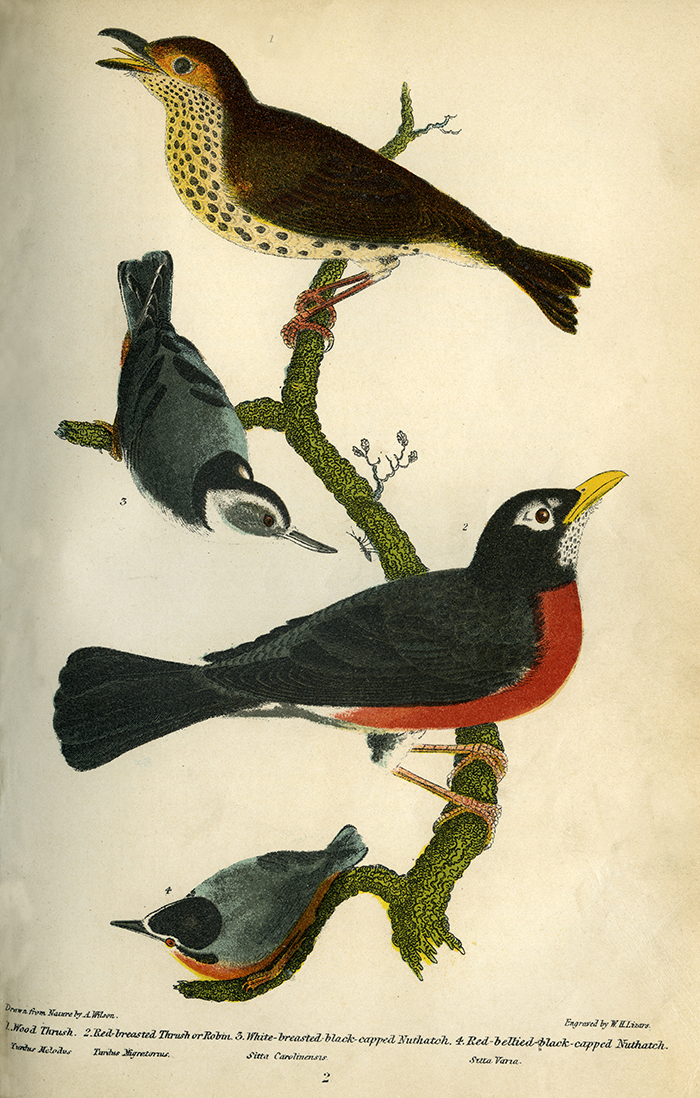
Bartram. p. 290.
Peale’s Museum, No. 5264.
TURDUS MUSTELINUS.—GMELIN.
Bonap. Synop. p. 75.
Penn. Arct. Zool. ii. p. 337.
The Wood Thrush, Aud. p. 372.
This bird is represented on the plate of its natural size, and particular attention has been paid to render the figure a faithful likeness of the original. It measures eight inches in length, and thirteen from tip to tip of the expanded wings; the bill is an inch long the upper mandible, of a dusky brown, bent at the point, and slightly notched; the lower, a flesh colour towards the base; the legs are long, and, as well as the claws, of a pale flesh colour, or almost transparent. The whole upper parts are of a brown fulvous colour, brightening into reddish on the head, and inclining to an olive on the rump and tail; chin, white; throat and breast, white, tinged with a light buff colour, and beautifully marked with pointed spots of black or dusky, running in chains from the sides of the month, and intersecting each other all over the breast to the belly, which, with the vent, is of a pure white; a narrow circle of white surrounds the eye, which is large, full, the pupil black, and the iris of a dark chocolate colour; the inside of the mouth is yellow. The male and female of this species, as, indeed, of almost the whole genus of thrushes, differ so little, as scarcely to be distinguished from each other. It is called by some the wood robin, by others the ground robin, and by some of our American ornithologists Turdus minor, though, as will hereafter appear, improperly. The present name has been adopted from Mr William Bartram, who seems to have been the first and almost only naturalist who has taken notice of the merits of this bird.[1].
[1] Almost every country has its peculiar and favourite songsters, and even among the rudest nations the cries and songs of birds are listened to, and associated with their general occupations, their superstitions, or religion. In America, the wood thrush appears to hold a rank equal to the nightingale and song thrush of Europe: like the latter, he may be oftentimes seen perched on the summit of a topmost branch, during a warm and balmy evening or morning, pouring forth in rich melody his full voice, and will produce associations which a foreigner would assimilate with the warblers of his own land.
“The song of the wood thrush”, says Mr Audubon, “although composed of but few notes, is so powerful, distinct, clear, and mellow, that it is impossible for any person to hear it without being struck with the effect it produces on the mind. I do not know to what instrumental sounds I can compare these notes, for I really know none so melodious and harmonical. They gradually rise in strength, and then fall in gentle cadence, becoming at length so low as to be scarcely audible.” They are easily reared from the nest, and sing nearly as well in confinement as when free.
Prince C. L. Bonaparte, in his “Nomenclature of Wilson’s North American Ornithology”, remarks, that our author was the first to distinguish the three closely allied species of North American thrushes by decided characters, but that he has nevertheless embroiled the nomenclature of this and his T. mustelinus:—“This bird being evidently the T. mustelinus of Gmelin and Latham, Wilson’s new name, which is not modelled agreeably to any language, must be rejected.”
The title for our present species, allowing Bonaparte to be correct, and of which there appears little doubt, will therefore now stand, Wood Thrush, Wilson; Turdus mustelinus, Gmelin; and T. melodus will come in as a synonym; while Wilson's T. mustelinus, being without a name, has been most deservedly dedicated to the memory of the great American ornithologist himself.—Ed. [return]

